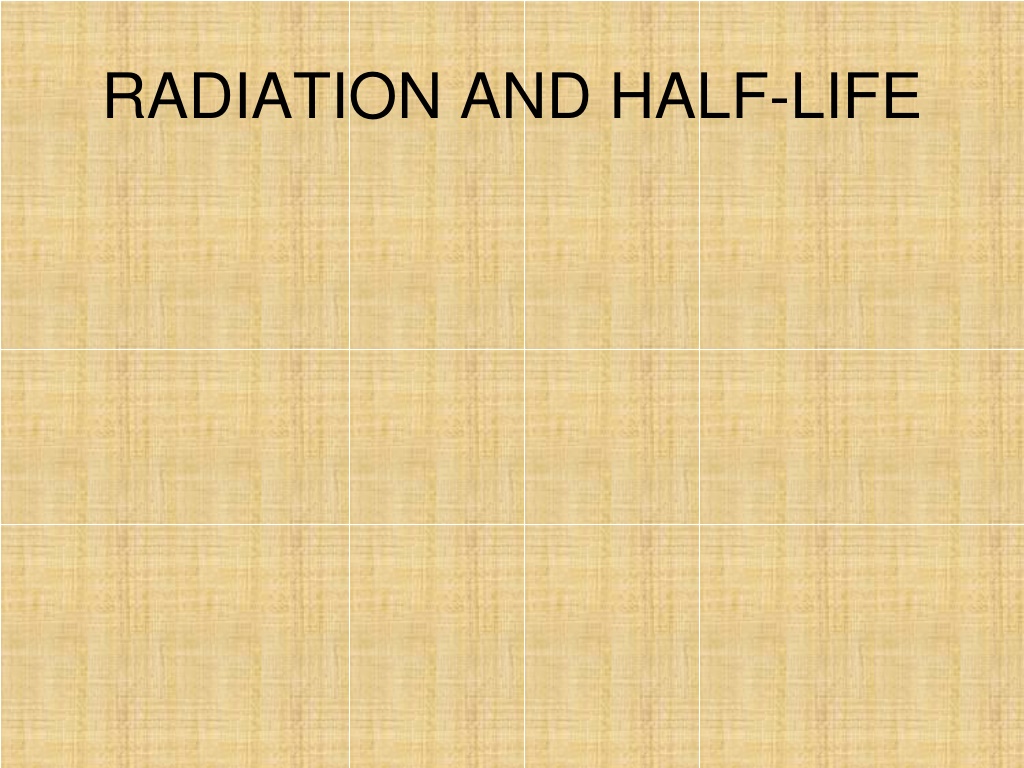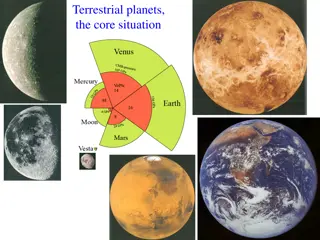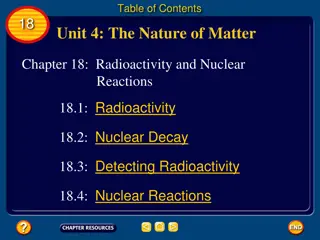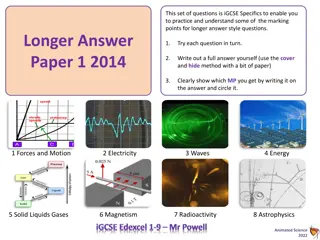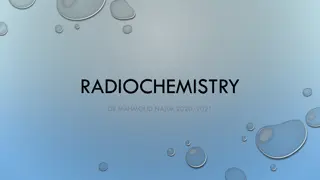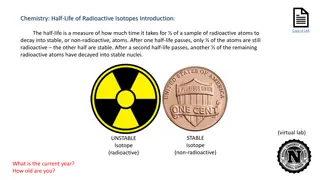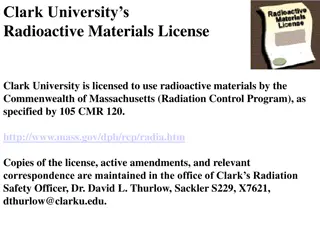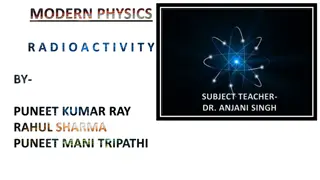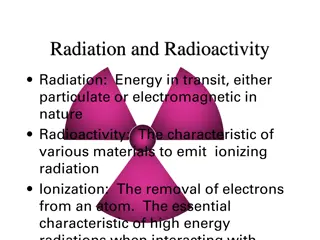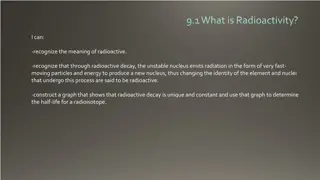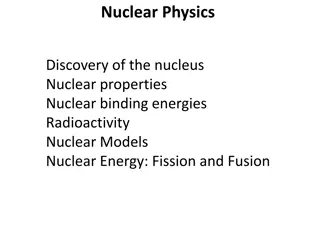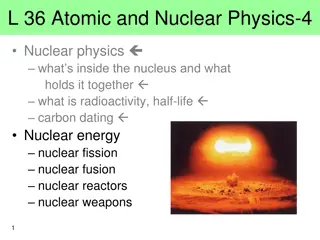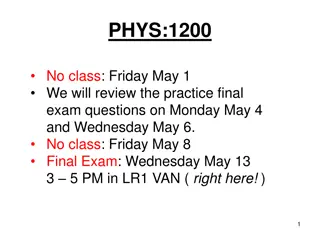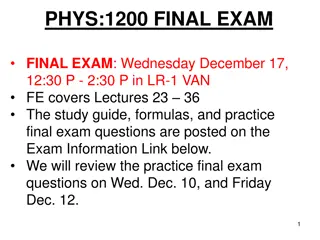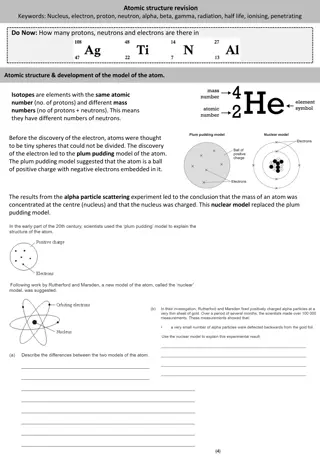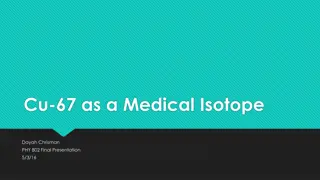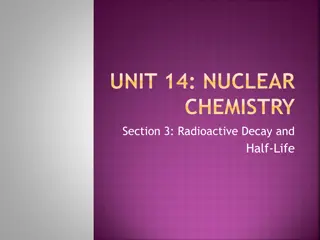Radioactivity and Half-Life
Explore the principles of radioactivity, detection methods, radiation badges, Geiger tubes, activity measurement, and calculations related to radioactive decay and half-life. Learn how to detect radioactivity, interpret radiation exposure, and calculate average activity in becquerels using simple formulas.
Download Presentation

Please find below an Image/Link to download the presentation.
The content on the website is provided AS IS for your information and personal use only. It may not be sold, licensed, or shared on other websites without obtaining consent from the author.If you encounter any issues during the download, it is possible that the publisher has removed the file from their server.
You are allowed to download the files provided on this website for personal or commercial use, subject to the condition that they are used lawfully. All files are the property of their respective owners.
The content on the website is provided AS IS for your information and personal use only. It may not be sold, licensed, or shared on other websites without obtaining consent from the author.
E N D
Presentation Transcript
Specification Radioactivity and particles Radioactivity understand that ionising radiations can be detected using a photographic film or a Geiger-Muller detector explain the sources of background radiation understand that the activity of a radioactive source decreases over a period of time and is measured in becquerels understand the term half-life and understand that it is different for different radioactive isotopes use the concept of half-life to carry out simple calculations on activity
Detecting radioactivity Radioactivity can be detected using photographic film or a Geiger counter. Radiation badge containing photographic film Geiger tube and counter
Radiation badges Photographic film darkens on exposure to radiation and light. Light cannot penetrate the badge but ionising radiation can. Darkening of the film indicates that a person has been exposed to too much radiation. Engineer at CERN wearing a radiation badge
The Geiger tube Radiation produces ions in a low pressure gas between a central positively charged electrode and the outer negatively charged tube. A pulse of current then flows that is registered by the counter. The thin mica window allows the least penetrating radiation (alpha) to enter the tube. Gamma radiation and most beta can enter through the sides of the metal tube.
Activity The activity of a radioactive source is equal to the number of decays per second. Activity is measured in bequerels (Bq) 1 becquerel = 1 decay per second Henri Becquerel discovered radioactivity in 1896
Question 1 A radioactive source undergoes 72 000 decays over a ten minute period. What is its average activity in becquerels?
Question 1 A radioactive source undergoes 72 000 decays over a ten minute period. What is its average activity in becquerels? Activity in becquerels equals decays per second. 72 000 per 10 minutes = 72 000 / 10 per minute = 72 000 / (10 x 60) per second = 72 000 / 600 = 120 per second Activity = 120 becquerel
Question 2 A radioactive source has an activity of 25 Bq. How many decays would be expected over a 3 hour period?
Question 2 A radioactive source has an activity of 25 Bq. How many decays would be expected over a 3 hour period? Activity is 25 Bq = 25 decays per second = (25 x 60) = 1500 decays in one minute = (1500 x 60) = 90 000 decays in one hour = (90 000 x 3) decays in 3 hours Number of decays in 3 hours = 270 000
Background radiation Background radiation is low-level ionising radiation that is produced all of the time. Most of this radiation occurs naturally but a small amount is due to man- made sources such as nuclear weapon testing.
Radon gas Radon gas accounts for about 50% of natural background radiation. Two isotopes of radon, radon 222 and radon 220 (also known as thoron) are produced by the radioactive decay of uranium and thorium in the Earth s crust . This gas seeps into the atmosphere sometimes building up first inside the basements and foundations of buildings. Areas containing granite and other igneous rocks, for example Cornwall, have a higher than average amount of background radiation due to radon gas. Background radiation map of England and Wales
Cosmic rays Cosmic rays are a form of natural background radiation produced by the nuclear reactions occurring in stars and exploding stars called supernovae. These produce high energy particles which continually bombard the Earth. Exposure to cosmic radiation is increased during jet travel Our atmosphere gives us good protection from cosmic radiation. Cosmic radiation is an issue that must be considered in proposed manned space exploration to Mars.
Internal radiation Internal radiation is background radiation due to radioactive sources present inside our bodies. Some of these are from naturally occurring events. An example is carbon 14 that is formed in the atmosphere by the Sun s radiation. This behaves chemically and biologically in the same way as non- radioactive carbon 12. Others such as strontium 90 are from man-made events such as nuclear weapons testing and accidents. Strontium behaves like calcium in our bodies. We are all sources of background radiation!
Artificial radiation Artificial radiation is background radiation due to man-made events or procedures Some is to due leakage and accidents associated with the generation of electricity using nuclear energy. Some is due to fall-out from nuclear weapon testing. The explosion of the Chernobyl power plant in the Ukraine in 19986 placed significant radioactive isotope into the atmosphere. Radioactive tracers are used in industry and medicine and radioisotopes are used to treat cancer. Overall artificial radiation normally accounts for only a small percentage of background radiation.
Background radiation pie-chart
Choose appropriate words to fill in the gaps below: Radioactivity was first discovered by Henri ___________ in 1896 when he noticed that the radiation emitted by an ore of ___________ caused the exposure of a _____________ plate. Radioactivity can also be detected using a _________ tube connected to an electronic _________ or rate meter. Background radiation is mainly due to natural sources of _________ radiation such as from ________ gas that seeps out from rocks in the ground. WORD SELECTION: counter Geiger photographic radon Becquerel uranium ionising
Choose appropriate words to fill in the gaps below: Radioactivity was first discovered by Henri ___________ in 1896 when he noticed that the radiation emitted by an ore of ___________ caused the exposure of a _____________ plate. Becquerel uranium photographic Radioactivity can also be detected using a _________ tube connected to an electronic _________ or rate meter. counter Geiger Background radiation is mainly due to natural sources of _________ radiation such as from ________ gas that seeps out from rocks in the ground. ionising radon WORD SELECTION: counter Geiger photographic radon Becquerel uranium ionising
Half-life The activity of a radioactive sample decreases over time. The half-life of a radioactive sample is the average time taken for half of the original mass of the sample to decay.
Half-lives of some radioactive isotopes Uranium 238 = 4500 million years Uranium 235 = 704 million years Plutonium 239 = 24 100 years Carbon 14 = 5600 years Strontium 90 = 29 years Hydrogen 3 (Tritium) = 12 years Cobalt 60 = 5.2 years Technetium 99m = 6 hours Radon 224 = 60 seconds Helium 5 = 1 x 10-20 seconds
Example 1 - The decay of a sample of strontium 90 Strontium 90 has a half-life of 29 years. Year Mass of strontium 90 (g) 2012 18.2 In 2012 a sample contains 18.2g of strontium 90 2041 9.60 2070 4.80 The mass of strontium 90 in the sample halves every 29 years. 2099 2.40 2128 1.20 2157 0.60 When will the mass have fall to 0.15 g? 2215
Question 1 At 10am in the morning a radioactive sample contains 80g of a radioactive isotope. If the isotope has a half- life of 20 minutes calculate the mass of the isotope remaining at 11am. 10am to 11am = 60 minutes = 3 x 20 minutes = 3 half-lives mass of isotope = x x x 80g mass at 11 am = 10g
Question 2 Calculate the half-life of the radioactive isotope in a source if its mass decreases from 24g to 6g over a period of 60 days.
Question 2 Calculate the half-life of the radioactive isotope in a source if its mass decreases from 24g to 6g over a period of 60 days. 24g x = 12g 12g x = 6g therefore TWO half-lives occur in 60 days half-life = 30 days
Other ways of defining half-life In terms of activity of a source: The half-life of a radioactive source is the average time taken for the activity of the source to decrease to half of its initial value. In terms of the number of nuclei: The half-life of a radioactive isotope is the average time it takes for half of the nuclei of the isotope to decay into some other isotope.
Example 2 The decay of source Z Time Activity (Bq) Source Z decays with a half-life of three hours. At 9 am the source has an activity of 16000 Bq 9 am 16000 12 noon 8000 3 pm 4000 The activity halves every three hours. 6 pm 2000 9 pm 1000 midnight 500 When will the activity have fallen to 125 Bq? 6 am
Example 3 The decay of isotope X Isotope X decays to Isotope Y with a half- life of 2 hours. At 2 pm there are 6400 nuclei of isotope X. Time Nuclei of X 6400 Nuclei of Y 0 2 pm 4 pm 3200 3200 6 pm 1600 4800 8 pm 800 5600 10 pm 400 6000 midnight 200 6200 When will the nuclei of isotope X fallen to 25? 6 am
Question 3 A radioactive source has a half-life of 3 hours. At 8 am it has an activity of 600 Bq. What will be its activity at 2 pm? at 8 am activity = 600 Bq 2 pm is 6 hours later this is 2 half-lives later therefore the activity will halve twice that is: 600 300 150 activity at 2 pm = 150 Bq
Question 1 The decay of substance P Substance P decays to substance Q with a half-life of 15 minutes. At 9 am there are 1280 nuclei of substance P. Complete the table. Time Nuclei of X 1280 Nuclei of Y 0 9 am 9:15 640 640 9:30 320 960 9:45 160 1120 10 am 80 1200 10:15 40 1240 How many nuclei of substance X will be left at 11 am? 5
Question 4 A sample contains 8 billion nuclei of hydrogen 3 atoms. Hydrogen 3 has a half-life of 12 years. How many nuclei should remain after a period 48 years?
Question 4 A sample contains 8 billion nuclei of hydrogen 3 atoms. Hydrogen 3 has a half-life of 12 years. How many nuclei should remain after a period 48 years? 48 years = 4 x 12 years = FOUR half-lives nuclei left = x x x x 8 billion nuclei left = 500 million
Finding half-life from a graph The half-life in this example is about 30 seconds. 600 500 number of nuclei 400 A more accurate value can be obtained be repeating this method for a other initial nuclei numbers and then taking an average. 300 200 100 half-life 0 0 20 40 60 80 100 120 time (seconds)
Question 1 Estimate the half-life of the substance whose decay graph is shown opposite. 900 800 700 activity (Bq) 600 500 400 The half-life is approximately 20 seconds 300 200 half-life 100 0 0 10 20 30 time (seconds) 40 50 60 70 80 90 100
Question 2 The mass of a radioactive substance over a 8 hour period is shown in the table below. Draw a graph of mass against time and use it to determine the half-life of the substance. Time (hours) Mass (g) 0 1 2 3 4 5 6 7 8 650 493 373 283 214 163 123 93 71 The half-life should be about 2 hours:
Choose appropriate words or numbers to fill in the gaps below: The ________ of a radioactive substance is the average time taken for half of the _______of the substance to decay. It is also equal to the average time taken for the ________ of the substance to halve. The half-life of carbon 14 is about _______ years. If today a sample of carbon 14 has an activity of 3400 Bq then in 5600 years time this should have fallen to ______ Bq. 11200 years later the activity should have fallen to ____ Bq. The number of carbon 14 nuclei would have also decreased by ______ times. WORD & NUMBER SELECTION: 5600 nuclei eight half-life 425 1700 activity
Choose appropriate words or numbers to fill in the gaps below: The ________ of a radioactive substance is the average time taken for half of the _______of the substance to decay. It is also equal to the average time taken for the ________ of the substance to halve. half-life nuclei activity The half-life of carbon 14 is about _______ years. If today a sample of carbon 14 has an activity of 3400 Bq then in 5600 years time this should have fallen to ______ Bq. 11200 years later the activity should have fallen to ____ Bq. 5600 1700 425 The number of carbon 14 nuclei would have also decreased by ______ times. eight
